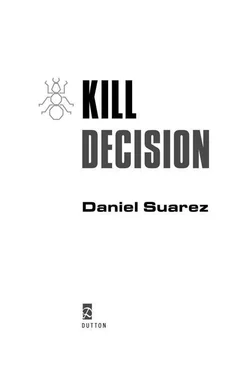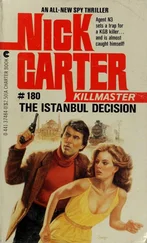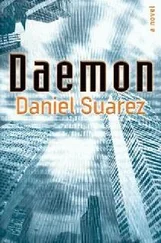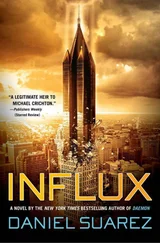Daniel Suarez - Kill Decision
Здесь есть возможность читать онлайн «Daniel Suarez - Kill Decision» весь текст электронной книги совершенно бесплатно (целиком полную версию без сокращений). В некоторых случаях можно слушать аудио, скачать через торрент в формате fb2 и присутствует краткое содержание. Жанр: Триллер, на английском языке. Описание произведения, (предисловие) а так же отзывы посетителей доступны на портале библиотеки ЛибКат.
- Название:Kill Decision
- Автор:
- Жанр:
- Год:неизвестен
- ISBN:нет данных
- Рейтинг книги:5 / 5. Голосов: 1
-
Избранное:Добавить в избранное
- Отзывы:
-
Ваша оценка:
- 100
- 1
- 2
- 3
- 4
- 5
Kill Decision: краткое содержание, описание и аннотация
Предлагаем к чтению аннотацию, описание, краткое содержание или предисловие (зависит от того, что написал сам автор книги «Kill Decision»). Если вы не нашли необходимую информацию о книге — напишите в комментариях, мы постараемся отыскать её.
Kill Decision — читать онлайн бесплатно полную книгу (весь текст) целиком
Ниже представлен текст книги, разбитый по страницам. Система сохранения места последней прочитанной страницы, позволяет с удобством читать онлайн бесплатно книгу «Kill Decision», без необходимости каждый раз заново искать на чём Вы остановились. Поставьте закладку, и сможете в любой момент перейти на страницу, на которой закончили чтение.
Интервал:
Закладка:
“We use algorithms to parse human activity-tracking the pulse and character of a place. Automating what we call ‘pattern of life’ analysis. Compiling a fingerprint, a signature of a city’s normal routine. Airborne persistent video pattern-recognition systems will be big in this surveillance effort-Bayesian algorithmic models…”
The general was still talking as Odin watched a constellation of red glowing dots and squares superimposed on the vast city, like ants.
“This layer represents observable human activity. The dots are people, the squares vehicles. Over time the subsystem differentiates which part of the imagery is static city and which is dynamic human activity. But it goes further. Within that human activity layer, EITS begins to accumulate experience of the patterns of human living that represent a city’s background noise-its norm. What travel patterns are followed each day from location to location-with each dot being tracked representing a trip marker that’s added to the database. The totality of trips weaving a pattern of behavior. How consistent is this pattern? What portion of residents follow a routine, leaving and returning to the same places on a general schedule? Which portion of the population has no regular schedule? That lets us focus on areas of suspicious activity-a common point somewhere in the city where individuals who’d been present at earlier ‘trouble spots’ might later congregate, a place that might be the lair of an insurgent group-the sort of intel that your group would previously have had to obtain through HUMINT-can now be gleaned from observing the totality of human activity. Remembering it over time. Seeing everything. Forgetting nothing.”
Odin watched the companion imagery as Lieutenant Gartner played impressive visual accompaniment to the general’s pitch. Odin appeared deep in thought. “Our PIR usually involves locating a specific individual, and for that cell phone SIGINT suffices. Our knob turners can isolate known voice patterns, trace the-”
“You mean as long as you can run manned listening flights over the target area, and we already do that with unmanned airships that can stay aloft for weeks.” The general nudged Lieutenant Gartner aside and clicked through a few menus to bring up another information layer.
The screen suddenly flipped to an entirely new field of hundreds of thousands of clustered dots, moving through the city.
“Every cell phone’s IMEI and the base transceiver stations that serve them. This system simplifies eavesdropping. Just identify the phone you want”-he zoomed in and clicked on an ID number moving through central Brazzaville-“and you can record the subject’s communications.” The sound of foreign chatter came in over the speakers.
The general relinquished control to Gartner again and turned to face Odin. “Think about the combination of persistent telecom and video surveillance-being able to go back in time to see what happened on a street corner two months ago, before you even realized that someone was a person of interest.” The general gestured to an image of the huge city, clustered with dots. “This system displays the social map of an entire city from the communications and geolocation data of its citizens…”
Lieutenant Gartner heard his cue and started making link-analysis webs visible on screen-dense strands that depicted the social network of the city’s populace.
The general was pacing, gesturing to the screen as he engaged in a rehearsed soliloquy. “A detailed social encyclopedia. Autodetection of suspicious activity…”
Gartner made certain the big screen did exactly that-showing a knot of young Congolese men pouring gasoline onto tires stuffed around another man’s torso, then setting it alight to horrific effect.
“Now we know not only the cell phones of this group but also their faces”-the image zoomed in to a leader in sunglasses and a beret-“their leaders. Their vehicles, their confederates-in short, everything.”
While the general talked, Odin wondered how much money they’d spent on this. In Vietnam it had taken an average of fifty thousand bullets to eliminate one Vietcong soldier. Had we upped the ante here? And what was the false positive rate? How many noninsurgents-people who simply matched a misguided pattern-were flagged by the system and handed over to security services or contractor hit squads for imagined or predicted crimes? Certainly, it was not in the interests of the folks running the system to admit it made mistakes.
Of course, Odin knew a system like EITS was not intended to resolve conflicts. It was intended merely to manage them. To keep violence disorganized, channeled, and isolated long enough to permit uninterrupted resource extraction. Once that was finished, the locals would be left to their own devices again. Rinse and repeat, and you pretty much understood the conflict map of the globe. This system let them know more about the locals than the locals knew about themselves. And it was just the beginning. There was no reason this couldn’t be done everywhere-including America, as Odin well knew. The only question was whether it had already been implemented there, in full or in part.
Odin interrupted the general, midpitch. “I was told there’s an autonomous strike capability to this system, General. Is that not the case?”
The general halted, took another sip of coffee, and nodded. “We both know lethal autonomy is inevitable, Sergeant. However, at the moment, we’re not using armed systems over this AO. This is a surveillance platform only.”
“Autonomous drones are part of the design specification, correct?”
“For surveillance, yes. Unmanned systems are how we coordinate complete coverage of the target area.”
“But weapons could be integrated.”
The general put his coffee mug down and studied Odin. “Kill-decision drones are a thorny issue, Master Sergeant. For the foreseeable future we’re keeping a human in the loop.”
“Is this the only implementation of the EITS system currently in use, General?”
“What are you looking for, Sergeant?”
Odin drummed his fingers on the railing while staring up at the screens. Then he focused his gaze on the general. “We both know the days of manned combat aircraft are numbered. Autonomous drones will be cheaper, more maneuverable, and expendable. And remotely piloted drones will be useless against a sophisticated adversary like China, Russia, Iran, or North Korea-they’ll just jam our link signal. That means we need to integrate autonomous drones into our military units. For patrolling and reacting to incursions.”
The general nodded and grabbed his coffee mug again. “We’re in agreement, then. It’s just a question of how long it will take Washington to realize it.”
They studied each other for a few moments in silence as the clattering of computer keyboards and soft radio chatter sounded around the control room.
The general gestured to the screens. “Impressive, isn’t it?”
Odin pondered the imagery. “I just have one concern, General.”
“And what’s that?”
“America pays for the difficult R and D to design these systems, and once they’re designed, they might get away from us. And then there’s the second- and third-order effects of technology like this. Surveillance drift nets create opposition-opposition from a public that doesn’t want technological domination. They’ll innovate ways to evade it, and it’s quite possible we could wind up causing more conflict than if we’d never built it.”
The general just stared at him.
“Just a thought…”
CHAPTER 12
Linda McKinney disembarked from a white, unmarked private jet, descending the steps into a cold winter night. Though idling, the plane’s engines were still deafening, its navigation and strobe lights flashing.
Читать дальшеИнтервал:
Закладка:
Похожие книги на «Kill Decision»
Представляем Вашему вниманию похожие книги на «Kill Decision» списком для выбора. Мы отобрали схожую по названию и смыслу литературу в надежде предоставить читателям больше вариантов отыскать новые, интересные, ещё непрочитанные произведения.
Обсуждение, отзывы о книге «Kill Decision» и просто собственные мнения читателей. Оставьте ваши комментарии, напишите, что Вы думаете о произведении, его смысле или главных героях. Укажите что конкретно понравилось, а что нет, и почему Вы так считаете.











